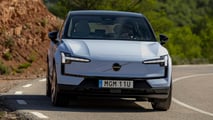The new Volvo EX30 has certainly been turning heads in recent months due to the crossover’s affordable starting price and the surprising performance of the twin-motor version. The consensus so far has been that the EX30 works great as a daily commuter or a couple. However, as a family vehicle, your mileage may vary due to its cramped rear seating and limited trunk space.
Reviewers have generally been kind to the EX30 in recent comparisons with competitors. Although several publications have noted limitations regarding size, annoyances with the all-touchscreen interface, and some unusual charging quirks.
Get Fully Charged
The Volvo EX30 Twin Motor Performance
The EX30 Twin Motor is an impressive electric crossover with 422 horsepower and 400 lb-ft (543 Nm) of torque and a 0-60 time of only 3.4 seconds. While it may be a blast to drive, it comes up short in important categories like efficiency, leg room and luggage capacity.
But how does it compare with competitors from within Volvo’s electric car lineup? The YouTube channel Kris Rifa recently decided to pit the EX30 against the Volvo C40 for a 379-mile (610-km) road trip test. In this race, they drove from Norway’s capital, Oslo, to Togstasjon Kristiansand at its southernmost tip.
Their goal was to arrive as quickly as possible and with the least amount of time spent charging. The C40 would seem to have an advantage here with more range and more robust fast charging beginning with the 2024 model year. Still, a superior charging strategy and more efficient driving on the part of the EX30 driver might overcome any inherent limitations.
Kris Rifa, who was behind the wheel of the EX30, used A Better Routeplanner to help optimize his charging strategy. He planned to make one more charging session than the C40 but spend less time at each stop. This would hopefully allow him to take full advantage of the vehicle’s peak charging speeds.
At the start of the race, the EX30 had estimated that it would arrive at the first charging stop with 17% state of charge (SOC) remaining. However, after the first hour, this projection began to drop down into the single digits. At this early stage of the race, the C40 Twin appeared to be performing more efficiently, averaging (22.2 kWh / 100 km) versus the EX30 Twin Performance’s average of (22.5 kWh / 100 km). The hosts theorized that the shape of the C40 gives it superior aerodynamics compared to the EX30, which is especially important at high speeds.
After more than two and a half hours, the EX30 was now estimating only 4% upon arrival at the planned first charging stop. At this exact point of the trip, the C40 Twin estimated 18% remaining for its arrival.
“This is the second EX30 I’ve taken on this trip where the estimation is really off.” Kris said in frustration. “It started with 17% and it’s now showing 4%? Yeah, that’s really bad and I don’t understand why.”
The vehicle’s software doesn’t seem especially reliable for this specific function, estimating driving ranges that it simply cannot deliver. Because of this, he decided to charge sooner than planned to avoid arriving with less than 10% charge. In most other EVs, plugging in at 4% would be acceptable. However, the EX30’s charging speeds are dramatically reduced if you plug in below 10%.
By the end of the trip, the EX30 averaged 21.7 kWh / 62 miles (100 km), pointing towards an average of 177 miles (286 km) of range on the highway (or 63.6% of WLTP range). The car required 3 charging stops along the way, but across those three stops, Kris only spent 31 minutes charging. This is consistent with the highway range Bjørn Nyland saw in his recent test.
The C40 ended the trip averaging 23.0 kWh / 62 miles (100km) and 204 miles (329 km) of highway range (59.8% of WLTP range). The trip required only 2 charging stops, but each stop was several minutes longer than the EX30. Still, he only spent 32 minutes charging, one minute longer than the EX30.
The C40 did arrive first at the final destination with 8% battery remaining. The EX30 arrived just a minute or two later with a whopping 0% SOC. This is despite the fact that after leaving the final charging stop, the vehicle estimated it would arrive with 11% battery remaining. So, on a different day, in different driving conditions, the EX30 may have had to make an extra 4th charging stop, extending its C40’s lead. This continued unpredictability could result in major issues for EX30 drivers when driving long distances. Whereas the C40's arrival estimates were quite accurate throughout the trip.
If you own an EX30, what is your impression of the vehicle so far? Have you had the same issue with arrival estimates demonstrated here? Let us know in the comments below.
Gallery: 2025 Volvo EX30 First Drive














